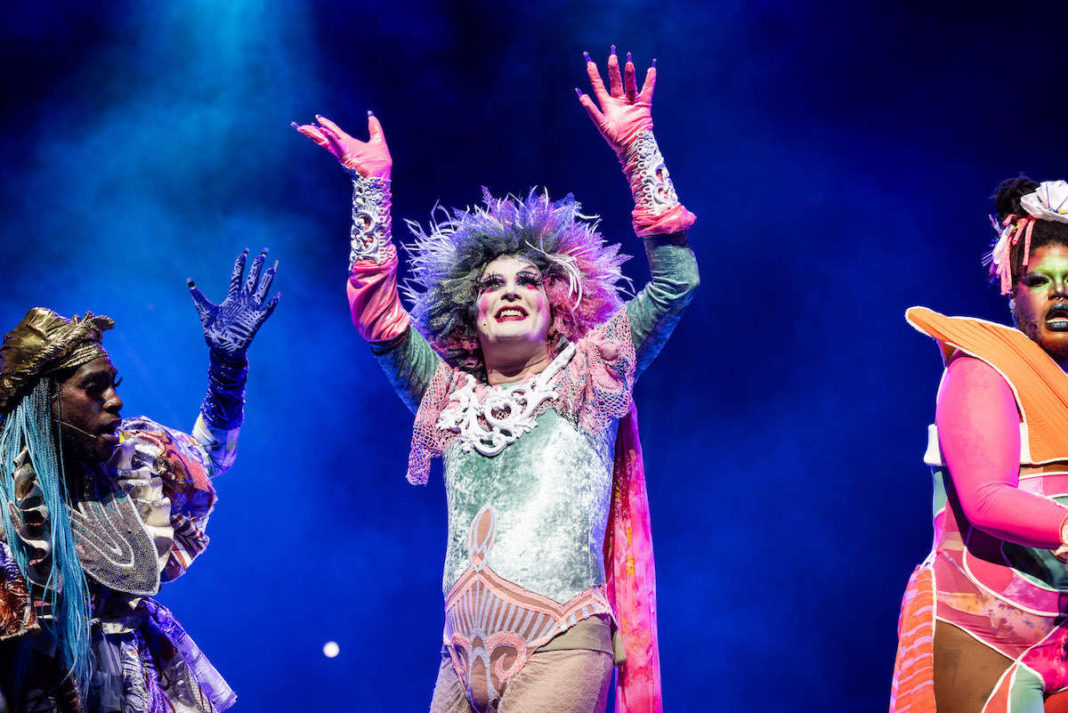Theatrical phenom Taylor Mac and collaborator Matt Ray’s newest project sweeps into Zellerbach Hall for three performances in late February. Titled Bark of Millions: A Parade Trance Extravaganza for the Living Library of the Deviant Theme, it is a four-hour “rock opera meditation on queerness,” that in the Cal Performances Berkeley version will include 55 songs, one for each year since the Stonewall Uprising.
“Most of my adult life has been seeking…for a collaboration that centers the queerness,” Mac commented for a short documentary on the making of Bark of Millions.
But unlike Mac and Ray’s multi-award-winning 24-Decade History of Popular Music, the songs in Bark of Millions don’t correspond to a particular time period, according to Ray, reached by phone from New York. Instead, they’re intended to provide “a connection with our queer forebears,” reaching back to the Egyptian gods and forward through history, paying tribute to icons as diverse as Marsha P. Johnson and Oscar Wilde.
“Taylor got the idea during the 24-Decade project,” said Ray. “He said, ‘Our history didn’t start with Stonewall.’” But the years since the groundbreaking 1969 event provided “an excuse for 55 songs,” joked Ray. These cover all genres of American music, including blues, jazz, disco and Motown, he said.
In another difference from 24-Decade, Ray said, “We aren’t teaching [queer history]…we want people to have a spiritual experience.” For instance, in the documentary, Mac says, smiling, “I want people to leave more queer, including the queer people. Kind of reverse conversion therapy.”
Mac and Ray met in 2008 during rehearsals for Mac’s The Lily’s Revenge. “They were looking for someone to be a rehearsal pianist,” Ray said. “I ended up music directing that show.” Bark of Millions is the pair’s fifth show together.
The word “bark,” Ray noted, can mean both “boat” and “shout.” And so it encapsulates the combined notion of sailing through time and speaking out loud and proud in tribute to the millions of queer people throughout human history, many of whom could never publicly express their true selves.
A multi-member cast includes people from Ireland, Australia and, in the case of famed drag artist Le Gateau Chocolat, England/Nigeria. It also includes Bay Area actor/musician/educator El Beh, Ray said. “Taylor and Matty have a knack for feeling the energy of the person,” El Beh commented in the documentary. Ray agreed that his process means intimately listening to, and writing for, all the diverse voices.
Bark of Millions was workshopped several times, including a three-week residency at upstate New York’s Kaatsbaan Cultural Park, which allowed Ray to discuss song development with performers. Some songs were written during the workshop, some were discarded and others were modified based on feedback. A cast of this kind includes big personalities, Ray agreed. But the spirit of respect and cooperation fostered by the development process ultimately produced amazing results. “Big personalities are big for a reason,” he said.
Yet, Taylor Mac is always very clear about what he wants, and his vision inspires the artists working with him, said Ray. Co-directors Neigel Smith and Faye Driscoll, who also choreographed the production, supported that idea in the short documentary, which was filmed during the Kaatsbaan residency. “The residency allowed us to dig deep into the material, to find what is the best way [of expressing it],” Smith said.
Scenic designer Christine Jones described being “fueled by the ideas…to create a visual vocabulary” for the entire production.
Costume designer Machine Dazzle, whose costumes and sets were featured in Mac’s Pulitzer Prize-nominated A 24-Decade History of Popular Music, also performs in the production, and used the residency, he said, to imagine what he would want to be wearing during particular songs.
Dazzle’s vision has evolved over decades of work. After arriving in New York in 1994, he quickly made an impression on the downtown arts scene as an artist, costume designer, set designer, singer/songwriter, art director and maker. He describes himself as “a radical queer emotionally driven, instinct-based concept artist and thinker trapped in the role of costume designer, sometimes.” In 2019, he was commissioned by Guggenheim Works and Process and The Rockefeller Brothers to create Treasure, a rock-and-roll cabaret of original songs, including a fashion show inspired by the content.
For Bark of Millions, his “intricate, unconventional wearable art pieces” are absolutely essential to the operatic, over-the-top nature of the production.
Ray is fully aware that a four-hour show might be a challenge for some. But there is no expectation, he said, that people need to sit quietly in their seats the entire time. Coming and going, perhaps dancing in the aisles, will all be part of the experience.
Bark of Millions premiered at the Sydney Opera House in October. Ray explained they were invited as part of the iconic venue’s 50th anniversary, and that performing there was a “bucket list experience.” Based on the reviews, this was true for audience members as well.
“Ultimately we’re here for the music, and the music is mesmerizing. People often describe Mac and Ray’s previous show, A 24-Decade History of Popular Music, as a ‘religious’ experience and Bark of Millions has that energy too. This feels like a cross between the best house party you’ve ever been to, a tent revival, a hedonistic nightclub, and a ritualistic gathering: it’s queer church at its ecstatic best.” — The Queer Review
Feb. 23-25, Zellerbach Hall, calperformances.org.
New Visions of Bausch
World-renowned dancer/choreographer Pina Bausch’s vision was, until recently, a personal and private one. The German artist, who died in 2009, helped create a “neo-expressionist” dance form, now called “Tanztheater,” which combines stylized movement, sound and set design, and often focuses on investigating trauma. The company she created, Tanztheater Wuppertal Pina Bausch, continues to perform internationally, including, in February, at Zellerbach Hall.
Her dance to Stravinsky’s The Rite of Spring, first performed in 1975, will this time be presented by dancers outside of her company. An ensemble of more than 30 dancers from 14 African countries will enact a whole new interpretation of her work. A collaboration among the Pina Bausch Foundation, École des Sables and Sadler’s Wells assembled the cast. In the performance, according to Cal Performances materials, “Stravinsky’s searing, ominous score takes on new meaning through visceral choreography as a ‘chosen one’ is sacrificed.”
The dance double bill also includes a new duet, common ground[s], choreographed and performed by two dancers in their 70s, Germaine Acogny, known as the “mother of African contemporary dance,” and Malou Airaudo, a longtime dancer with the Tanztheater Wuppertal Pina Bausch.
A post-performance moderated discussion will be held on Friday, Feb. 16, and post-performance community conversations on Saturday and Sunday, Feb. 17 and 18.
Feb. 16-18, Zellerbach Hall. calperformances.org.











